AI Will Deliver Positive and Negative Results to the M&E Ecosystem

You may not have noticed it, but your grandfather’s and father’s “Golden Age of Television” has evolved a bit since the 1940s; to the point where there not only delivered into your living room, but anywhere you’d like it. In fact, it’s become real personal.
The M&E (media & entertainment) industry first called the 40s-50s the Golden Age because it was live shows with everyone huddling around the TV set and eyes were glued to whatever was on. It was all about big productions, big ad budgets, big audiences.
The second Golden Age came when we had cable and satellite TV. With it, we had an embarrassment of riches – big bundles of hundreds of mainstream, specialty choices that would take you hours to click through and choose what you wanted to watch. There were good/bad productions, ad budgets spread around and audiences measured in the millions +/-.
The third Golden Age came when the Internet became strong enough to handle tens of thousands of simultaneous video streams. The cost of entry dipped and ad people struggled to have promotions everywhere/anywhere…just in case.
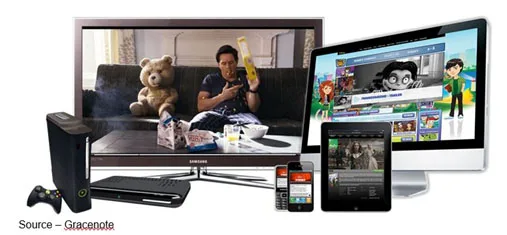
Golden Age 3.5 came around and suddenly people were watching what they wanted, when they wanted and (on a device) anywhere they wanted.
Without even noticing it, we’ve entered the fourth Golden Age and everyone in the industry is fiddling around with different “mixture” experiences and technology to become efficient delivering everything–education, information, entertainment, ad messages.
The challenge is it’s not a target of millions or more correctly 7B plus, it’s personal…very personal.
And the key is to attract enough like-minded individuals to make it profitable.
For example, my son has three current fave TV shows.
Can’t get enough of them.
He streams them to all of his screens, binges them, recommends ‘em to others/provides links, chats about them online, posts highlights, mashes up his own versions and shares the stuff with other like-minded folks.
He can’t wait for spin-offs and franchise extensions to hit his screens.
That’s what studios/networks are used to:
- Friday the 13th
- Halloween
- Bond
- Star Wars
- Real housewives of (city)
- NCIS
- Cop, fireperson, emergency, hospital
Curious about his shows, I asked my son what network they were on, what night/time.
He didn’t have a clue. He was watching them OTT (over the top). When he wanted them…BAM!! they were there.
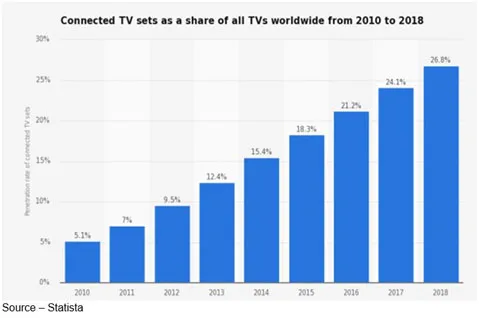
While we get our content on a connected TV, there are a lots of ways people are bypassing the cable/satellite to pick and choose their content/times using a game console (PS4), streaming media player (Roku), smart blu-ray player (Panasonic) and DVR (digital video recorder – TiVo).
When Netflix moved to building a more efficient global download to burn content delivery, they partially picked their content offerings based on the information generated on who and where subscribers received Netflix’s red envelopes.
People liked the instant gratification of choosing the show they wanted and were willing to wait a minute or two to download it versus going to the local store or receiving it in the mail. As delivery networks became more efficient, more stable and with a higher rate of speed; the presentation model evolved into a more secure streaming model. This was combined with an array of great content and a viewing audience was created, enabling cost savings as well as new programming to fill the pipes with stuff the audience wanted. Life was good for everyone.
This enabled Netflix to move up the M&E chain and it became more of a media network with unique content and on-demand service that folks couldn’t get anywhere but from the streaming service…so cool, so elite.
Through their data-insight, Netflix knew what stuff the viewer wanted, how they wanted to view it, how long and when they got tired of it because…the viewer told them.
Bezos saw what Netflix’s Hastings was doing and figured with a little tweaking of their algorithms/data, Amazon could take their insight from their customers and be just as huge in entertainment; but with a wider offering of content from established folks to up-and-comers.
Additionally, to take a big bite out of the M&E industry (and leverage their ad abilities), Facebook and Google/YouTube have had the tremendous advantage because kids/millennials were already used to coughing up personal info – photos, connections, videos, personal data, friends/family – in return for some good entertainment.
Combining all of this and a new battle for the viewer has ensued, creating a path for past programming models to quickly erode.
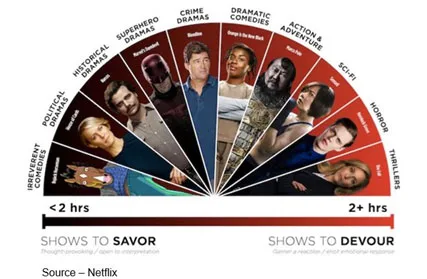
Without making a big deal out of how they were selecting the shows, Netflix and Amazon recognized that if they were to grow, they were going to need to provide new forms of exclusive programming and viola! they found a visually hungry and loyal audiences.
Both honed a technology that had been around for a long time and had been the subject of countless sci-fi movies/books – AI (you call it artificial, I call it augmented intelligence).
Unlike “2001” or “The Terminator” that promised AI would take you out, this form of AI studied what you watched, when you watched it and how you watched it; giving Netflix, Amazon and a newcomer (Hulu) as well as EU provider MoviStar a viewing behavior and content roadmap. The people were happy.
The more information you give AI, the more it “learns” who the viewer is, what the viewer likes; and the recommendations become second nature and provide tremendous comfort.
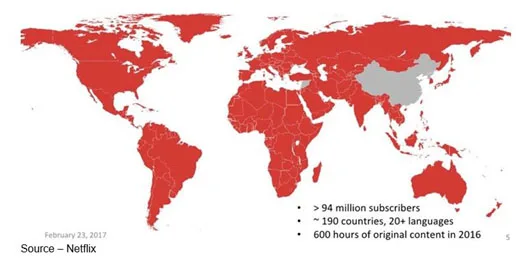
And if it worked at home in the U.S.; heck, it would work around the globe because people are people and they all have similar but different interests.
But Netflix and Amazon’s AI solution (and most others) are like idiot savants – very, very good at one job and very helpful in filling your time with stuff you want, even if you don’t know you want it.
Another example is IBM’s Watson. It won at Jeopardy! but had to be reprogrammed to do something/anything else, which has led it into M&E program recommendations.
Alphabet’s AlphaGo could make all the right moves – many counterintuitive – to win the 2500-year-old Chinese game of Go too, but sucked other games.

Even as cable, satellite and network executives struggle to adjust to the new content world, the quartet may have a slight advantage when it comes to relationships with real consumers; but Hulu, Vimeo, Alibaba and all the OTT services have had a major impact on how people consume content.
In just two years, the move to streaming has been dramatic.
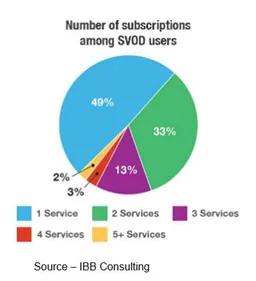
Today, more than 70 percent of US households stream at least one OTT service. Netflix, on its own, has more subscribers than the major cable firms…combined.
Seeing their numbers shrink, legacy providers/networks are attempting to go virtual as well to maintain their profits. HBO, Showtime, Discovery, AMC, E&A and ESPN are all trying to retain their viewers’ eyeballs instead of letting them wander.
The problem is all of them are struggling to maintain their brand share, while the new breed could care less.
Yes, there has been a significant shift globally in the way people view their content; but they are going about it all wrong, trying to build a brand with the new viewers.
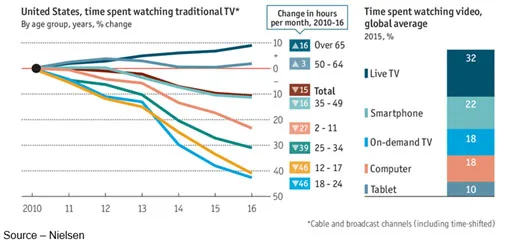
Industry observers have been shorting Netflix because they have recently been killing off shows they have invested heavily in; saying, “See, it’s a failing concept they won’t be able to sustain for long.”
The industry is still basing its decisions on the past when there was some network loyalty.
According to Ampere Analysis, more than 50 percent of Netflix’s audience is younger than 34, while 23 percent are 35-44.
Unlike older viewers, they don’t have a routine, history or commitment to a specific channel or series. These viewers have a short attention span and are constantly seeking what’s new, different, popular and of interest right now!
It’s going to create a problem for sports and live events because a recent Yahoo study showed:
- 27 percent of respondents want to watch at their convenience
- 19 percent don’t want to be restricted to a specific viewing time
- 18 percent like to fast-forward through the dull stuff
And when it comes to the new audience – 24 and younger – Nielsen found that around 40 percent ignore traditional TV – day, time, channel, network – to focus on the content, show, specifics that interest them.
So, what does tomorrow look like?
Globally, OTT will continue to expand with the younger audiences who will become key influencers, making it increasingly difficult to predict behavior using the past as a guide.
VOD will continue to persist and new flavors will be created:
- SVOD – subscriptions will maintain a strong market share, relying heavily on AI-based recommendations to anticipate and suggest new, different content to keep interest high (and profitable); but long-term sports subscriptions will be difficult to develop/maintain.
- TVOD (transaction video) will be a major part of the sports, events and tentpole film industries with people paying for specific events, activities but very unwilling to make a long-term commitment. Baseball, football, basketball, boxing, soccer and theatrical events will be modestly successful with subscriptions but the real profits will come from individual event transactions.
- AVOD from Google, Facebook and eventually Amazon will capture the new audience because free is always a strong incentive and people will actually be getting ads they want to see.
Tapping into and monitoring the global entertainment brain, AI technology will spend more time learning and understanding the content desires of individuals as well as massive groups of individuals to recommend viewing content and to recommend the development of content we don’t even realize we want to see/experience.
As a result, SVOD services like Netflix will create new shows and new series more frequently and will kill off material before its broad appeal disappears (which maximizes their profits and adds subscribers).
Indirectly, that’s good news for AVOD services because that content still has a large market share and viewership. Access will continue for a long time.
What about economic demographics? Affluents will pay for subscriptions or TVOD, while AVOD subscribers will have lower income levels and be more willing to view ads if their viewing is free.

Even though shows/series that subscription viewers have streamed and binged on still have a decent audience size, they won’t fit into the new intelligent formula for strong viewing recommendations as the feedback/feedforward systems become more cognitive.
A more applicable form of AI, deep learning, can go even deeper to intelligently assist in the development/production/delivery of much more satisfying/rewarding content.
Netflix CEO Reid Hastings recently noted that their success rate is too high with its originals and episodic series and they need to take more chances.
But if you look behind the subscription growth internationally, it’s darn smart move to be continually uncomfortable.
The company is focusing on serving up even more “gotta’ view/different” content for existing customers who recommend their service to even more people.
Financial analysts say it’s a dumb move…perhaps dumb like a fox!
People aren’t buying bundles – big, small, fat, skinny; they’re buying content…their content.
“Canceled originals aren’t failures,” Allan McLennan, president of the PADEMGROUP, again noted. “Subscribers always want new, fresh, different and Netflix, along with Amazon Prime and a few others are willing to take that risk to grow.”
“Amazon, Google and Facebook have all stated they are expanding their own content productions and can grow their revenues by negotiating and giving new life to what is perceived as discarded content and shows. It’s a very fluid market,” McLennan continued.
Shows like Loosely Exactly Nicole, Last State Standing and a broad range of films/series still have a significant following as well as a secondary audience that isn’t even familiar with them – they’re new to them and that’s a good thing.
“Today, the content is the brand, not entirely the network/channel. The series, the artist, the event is increasingly the value to the viewer. The networks that have more of this programming on their channels will secure a stronger position in the eyes of both current and especially new viewers. Securing these new audiences by intelligent accessibility via their ‘personalized TV dial” will be a key driver,” McLennan emphasized.
The real benefit deep learning and AI have (indirectly to the viewer and directly to the content delivery network and advertiser) is the wealth of detailed information that is available and the ability to quickly, intelligently and accurately act on that information.
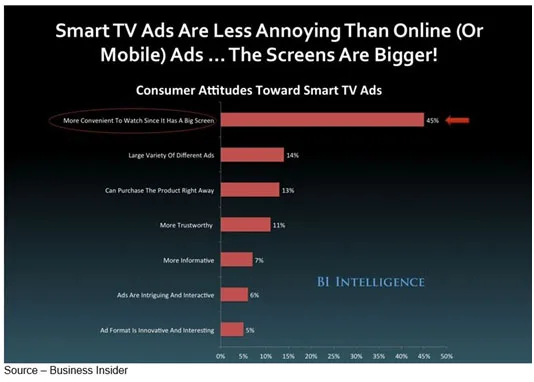
We’ve said it before and we’ll say it again, people don’t dislike ads with their content.
They dislike (hate) bad ads!
Deep learning AI comes to the rescue.
The neural net, GPU (graphics processor unit)-powered AI technology that is being constantly getting deeply ingrained in the M&E industry has a good chance of delivering what everyone wants – insanely great content surrounded by ads that people want to view and act on.
Forget the technology behind it.
Just imagine you’re watching your show and Adobe Media/Audience Manager/PrimeTime, Ad Cloud, Siemen’s Smart Video Engine or some other AI-based system makes a series of smart, fast decisions to offer someone’s programming and attached to that programming are associated ads that are precisely and uniquely tied to that viewer’s interests. The experience will become increasingly more valuable.
By continuously capturing meaningful information about what you watch, how long you watch it, where you visit next, what you file/discard, your interactions/posts and other stuff; the system can deliver up ad content tailored to your beliefs, motivations, interests, wants and needs.
That’s a lot more interesting, a lot more helpful than a bunch of meaningless ads following you around the web and social media.
They’re a pain in the behind, but this is something you’re actually interested in…cool!
According to Forrester, that granular approach actually improves customer engagement 4-8 times over yesterday’s methods; and it’s something that legacy TV organizations can’t do–even if they wanted to (and they don’t).
Pre-roll, mid-roll, post-roll; it doesn’t really matter; you’re gonna’ watch and be educated, informed and entertained as never before.
Satisfaction – for all parties – overrides any concern you might have about AI replacing you when you’re in the center of it all.
Of course, not taking full advantage your competition can destroy you; so I guess indirectly, AI played a part.
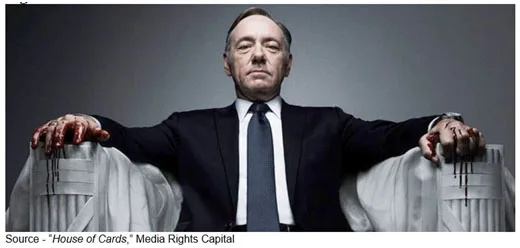 As Francis Underwood said, “The road to power is paved with hypocrisy. And casualties.”
As Francis Underwood said, “The road to power is paved with hypocrisy. And casualties.”
# # #